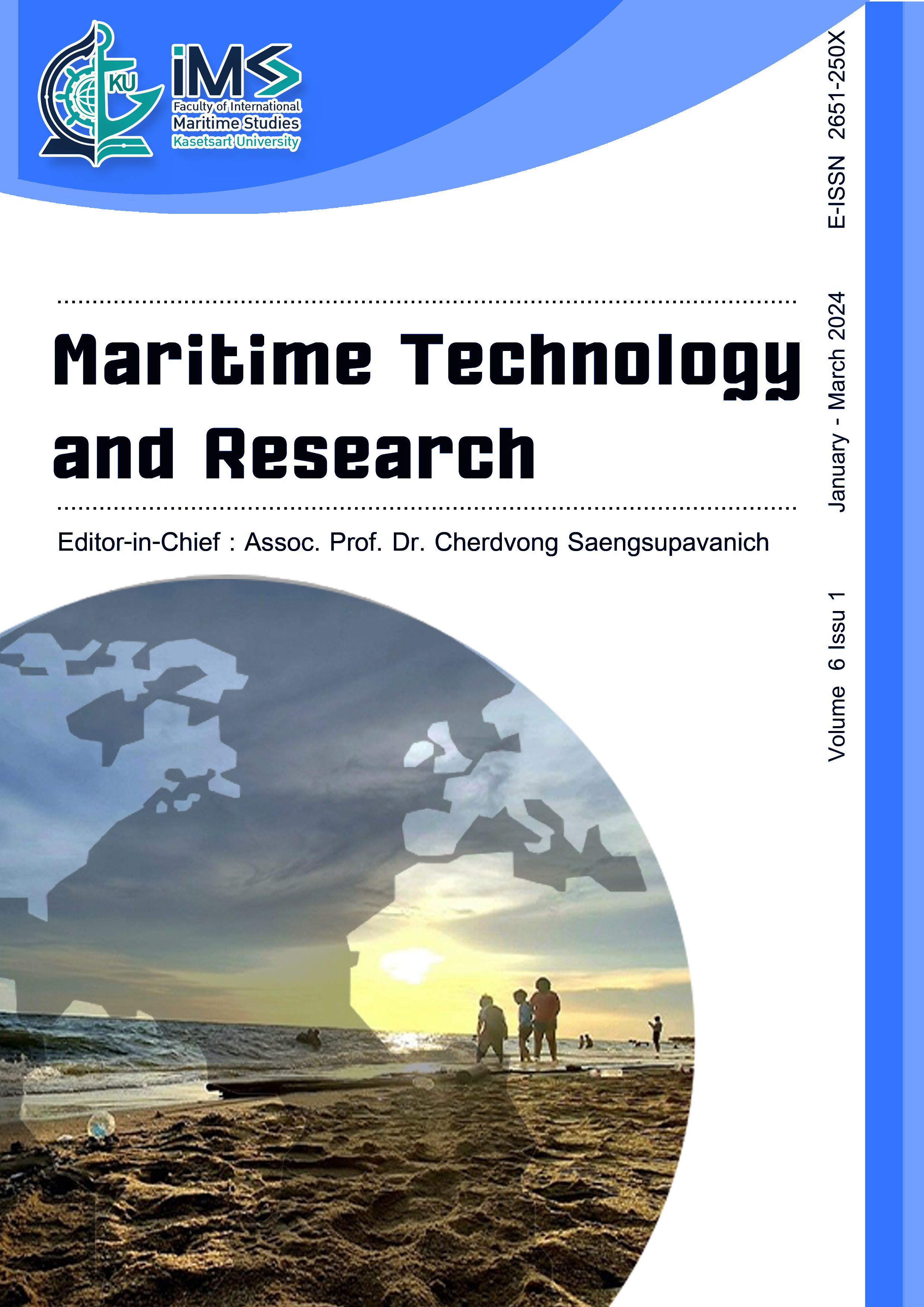Effect of refraction and field of view of acrylic viewports of shallow water spherical pressure hull
DOI:
https://doi.org/10.33175/mtr.2024.266792Keywords:
Manned submersible, Spherical pressure hull, Viewport, ASME PVHO-1, Refraction, Field of viewAbstract
A shallow water spherical hull for manned submersible has been designed and developed by National Institute of Ocean Technology, India. During the design phase, a detailed study was carried out concerning the conical acrylic viewports, to understand the limit of aperture, field of view through viewports, field of view of seafloor, and reflection. It is also important to understand the effect of refraction due to acrylic and sea water, which is significant for making engineering judgements while collecting samples from the seabed. This study recommends having larger diameter viewports and larger angles between the primary and secondary viewports. A limitation would be that increasing the diameter of the viewport would increase the size of the viewport flange.
------------------------------------------------------------------------------
Cite this article: Pranesh, B., Sathianarayanan, D. (2024). Effect of refraction and field of view of acrylic viewports of shallow water spherical pressure hull. Maritime Technology and Research, 6(1), 266792. https://doi.org/10.33175/mtr.2024.266792
------------------------------------------------------------------------------
Highlights
- The layout of the observation windows, field of view, field of view of the sea floor, and refraction effects are studied
- Effect of refraction due to acrylic and sea water, which is significant for making engineering judgements while collecting samples from the seabed
- The distortion depends on the viewing angle, thickness of the viewport window, and object distance inside the sea water
- Minimum overlapping regions in the fields of view of viewports need to be maintained so that two crews can see the objects together which fall in the common field of view
References
Alcocer, A., Forès, P., Giuffré, G. P., Parareda, C., Roca, A., & Roca, J. (2009). Pressure hull design and construction of the manned submersible Ictineu 3. Instrumentation Viewpoint, 8, 196443.
Allmendinger, E. E. (1990). Submersible vehicle systems design (Vol. 96). Society of Naval Architects.
ASME PVHO-1. (2016). Safety standard for pressure vessels for human occupancy. New York, NY: American Society of Mechanical Engineers.
Busby, R. F. (1976). Manned submersibles. Office of the Oceanographer of the Navy.
Carruthers, J. N. (1944). The oceans: Their physics, chemistry, and general biology. By H. U. Sverdup, Martin W. Johnson and Richard H. Fleming. New York (Prentice Hall, Inc.), 1942, × 6 × 21/4 ins., pp. X + 1087; circa 265 illustrations, 121 tables, 7 charts, very copious bibliographies. Ten dollars. Quarterly Journal of the Royal Meteorological Society, 70(304), 159-160. https://doi.org/10.1002/qj.49707030418
Cohen, A. (1995). A description of MIL-STK-1472. ACM SIGCHI Bulletin, 27(2), 48-49. https://doi.org/10.1145/202511.202524
Cui, W. (2013). Development of the Jiaolong deep manned submersible. Marine Technology Society Journal, 47(3), 37-54.
Cui, W. C., Xu, Q. N., Liu, T., Hu, Z., Yang, Y. N., Hu, Y., & Ma, L. (2008). Design and construction of the deep manned submersible ‘Harmony’. Ship Science and Technology, 30, 17-25.
Cui, W., Liu, F., Hu, Z., Zhu, M., Guo, W., & Liu, C. (2013). On 7,000 m sea trials of the manned submersible Jiaolong. Marine Technology Society Journal, 47(1), 67-82. https://doi.org/10.4031/MTSJ.47.1.2
Design: Hyperbaric facilities. (2004). Unified Facilities Criteria (UFC). Washington, DC: National Institute of Building Sciences.
Feng, L., Weicheng, C., & Xiangyang, L. (2008). Introduction to design and construction of deep manned submersible “Harmony”. In Proceedings of the International Conference of INMARTECH2008. Toulon, France: Ifremer.
Lones, J. J. (1980). Optical aspects of underwater windows with an overview on mechanical installation. Ocean Optics VI, 208, 84-126. https://doi.org/10.1117/12.958267
Mavor Jr, J. W. (1965). Observation windows of the deep submersible, ALVIN. Woods Hole Oceanographic Institution MA. https://doi.org/10.1575/1912/24640
McNeil, G. T. (1977). Metrical fundamentals of underwater lens system. Optical Engineering, 16(2), 162128. https://doi.org/10.1117/12.7972089
Pranesh, S. B., Sathianarayanan, D., Ramadass, G. A., Chandrasekaran, E., Murugesan, M., & Rajput, N. S. (2020). Design and construction of shallow water spherical pressure hull for a manned cabin. Ships and Offshore Structures, 17(1), 153-168. https://doi.org/10.1080/17445302.2020.1827634
Shuichiro, H., & Itsuro, M. (1990). Information processing and equipment arrangement in the pressure hull of ‘Shinkai 6500’ (pp. 76-94). Marine Technology, JPRS Report.
Stachiw, J. D. (1990). Ocean Engineering Studies (Vol. 1). Naval Ocean Systems Center. https://doi.org/10.21236/ADA235413
Stachiw, J. D. (2003). Handbook of acrylics for submersibles, hyperbaric chambers, and aquaria. Best Publishing Company.
Stachiw, J. D. (2004). Effect of ASME PVHO-1 safety standard on the design of viewports in pressure vessels. Underwater Intervention.
Trowbridge, T. (1971). Optical properties of a spherical plastic underwater observatory NEMO. Journal of Manufacturing Science and Engineering, 93(2), 710-716. https://doi.org/10.1115/1.3427987
Wang, F., Wang, W., Zhang, Y., Du, Q., Jiang, Z., & Cui, W. (2019). Effect of temperature and nonlinearity of PMMA material in the design of observation windows for a full ocean depth manned submersible. Marine Technology Society Journal, 53(1), 27-36. https://doi.org/10.4031/MTSJ.53.1.4
Downloads
Published
Issue
Section
Categories
License
Copyright (c) 2023 Maritime Technology and Research

This work is licensed under a Creative Commons Attribution-NonCommercial-NoDerivatives 4.0 International License.
Copyright: CC BY-NC-ND 4.0








